Pesticide Usage in Scotland: Rodenticides on Arable Farms 2020
This report presents the results of a survey of rodenticide use on arable farms in Scotland in 2020
This document is part of a collection
Rodenticide use data
Rodenticide use data were collected from 268 arable holdings in Scotland in 2020. The farms surveyed represented three per cent of the total arable holdings in Scotland. These holdings collectively grew seven per cent of the 2020 arable crop area. The data collected from this sample were used to estimate rodenticide use on all Scottish arable farms in 2020.
Percentage of farms using rodenticides and type of user
It was estimated that approximately 61 per cent of Scottish arable farms used rodenticides in 2020 (Figure 1). Over half of all baiting operations (57 per cent) were implemented by farmers. Pest Control Professionals (PCPs) conducted baiting on the remainder of these farms.
Similar proportions were recorded in relation to the amounts of rodenticides used with farmers responsible for 59 per cent of the total use by weight of product.
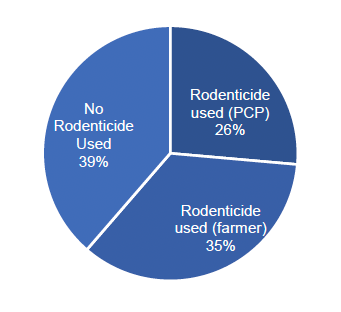
The estimated percentage of farms using rodenticides, and associated user type, in the previous two surveys (2016 and 2018) is presented in Figure 2. The proportion of arable farms using rodenticides in 2020 (61 per cent) was similar (p-value 0.17) to that in 2018 (55 per cent) but significantly lower than in 2016 (78 per cent, p-value <0.001).
In 2020, on farms where rodenticides were used, the proportion applied by PCPs (43 per cent) was lower than in 2018 (54 per cent, p-value 0.025) but similar to 2016 (40 per cent). Recent surveys, since the introduction of the Rodenticide stewardship scheme, have shown a trend of an increasing proportion of farms using PCPs to apply rodenticides. It is possible the decline in use of PCPs in 2020 was influenced by COVID-19 and the subsequent lockdown. Although pest management was classed as an essential sector during the pandemic some farmers may have preferred to conduct their own baiting rather than using external contractors, which may also have influenced the amount of rodenticides used. The impact of the pandemic on overall trends in baiting operations may be clearer in subsequent surveys.
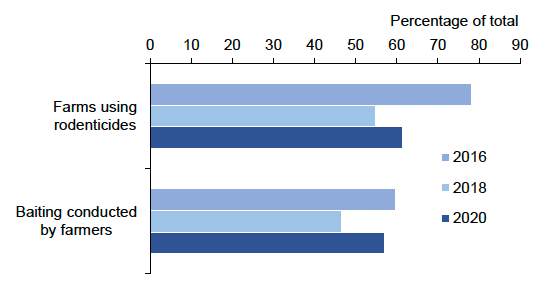
Note: There was no statistical difference in the number of farms using rodenticides (p-value 0.17) between 2018 and 2020. There was some evidence that the proportion of baiting conducted by farmers increased between 2018 and 2020 (p-value 0.025).
Rodenticides encountered and their estimated occurrence
During this survey, product information was recorded for 78 per cent of all occurrences of rodenticide use. For the remaining 22 per cent, whilst it was recorded that rodenticides had been applied, the product used was not specified. This was either a result of farmers not having adequate records of the exact product used or PCPs not responding to requests for product information. The level of unspecified rodenticides in 2020 was almost double that encountered in the previous survey (13 per cent), possibly linked to the change in data collection method in 2020 (see Appendix 4 - changes from previous years). The following sections only discuss the use of specified rodenticides.
Rodenticide occurrence is defined as the number of holdings on which a formulation (the combination of active substances formulated together in a product) is encountered. Multiple uses of the same formulation at the same holding are counted as a single occurrence (refer to Appendix 3 for further explanation of these definitions).
Five active substances were recorded on arable farms in 2020; brodifacoum, bromadiolone, coumatetralyl, difenacoum and difethialone (Figure 3, Table 1). All the rodenticides encountered were anticoagulants, which prevent the synthesis of blood clotting factors and cause rodent death by haemorrhage. One of the active substances was a first generation anticoagulant rodenticide (FGAR; coumatetralyl). The other four active substances were second generation anticoagulant rodenticides (SGARs) and these SGARs collectively accounted for more than 99 per cent of all occurrences of specified rodenticide use in 2020. Over the last three surveys rodenticide use has been almost exclusively composed of SGARs (>99, > 98 and >99 per cent in 2016, 2018 and 2020 respectively, no significant difference between years).
The most commonly encountered formulations were bromadiolone and difenacoum (47 and 44 per cent of occurrences respectively). Other formulations recorded were brodifacoum (seven per cent of occurrences), bromadiolone/difenacoum (one per cent), difethialone and coumatetralyl (both less than one per cent).
The dominance of bromadiolone and difenacoum occurrence reflects these being the most commonly available rodenticides. At the time of writing, bromadiolone and difenacoum containing products account for 57 per cent of all anticoagulant rodenticide approvals, 60 per cent of those approved for outdoor use around buildings and 99 per cent of those approved for use in open areas(3).
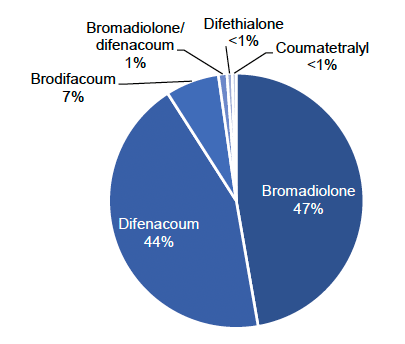
The combined use of bromadiolone and difenacoum has changed little over time, accounting for 92, 90 and 92 per cent of rodenticide occurrences in 2016, 2018 and 2020 respectively. However, the relative proportions of these two compounds have changed since the last survey. In 2020, the number of farms using bromadiolone was significantly lower (p-value 0.009) than in 2018. In contrast, significantly more farms used difenacoum in 2020 (p-value 0.002) than in 2018. However, the proportions of occurrences encountered in 2020 are similar to those encountered in 2016 (Figure 4). The mixed formulation bromadiolone/difenacoum, which accounted for one per cent of all specified occurrences in 2020, is the first formulation containing more than one active substance recorded in this survey series since 2014 (possibly as part of resistant management programmes). The relative proportions of these compounds vary in the longer-term dataset (1992 onwards) and it is not clear what the drivers for these variations are. It is possible that this may be a response to product efficacy in some areas; resistance to both difenacoum and bromadiolone has been reported in Scotland(4). It may also represent a response to differences in the range of approved products available and their marketing strategies over time.
The use of brodifacoum, the third most commonly encountered rodenticide in this survey (seven per cent), is very similar to that recorded in 2018 and 2016 (both six per cent).
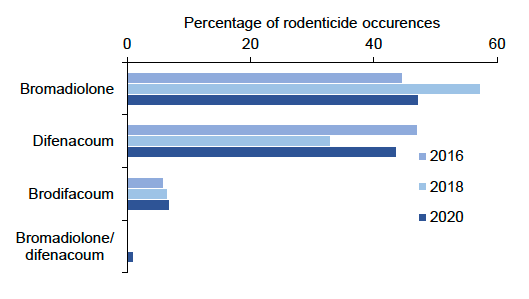
Note: Statistically fewer farms used bromadiolone in 2020 (p-value 0.009) than in 2018. In contrast, more farms used difenacoum (p-value 0.002). There was no significant difference for the proportion of farms using brodifacoum between 2018 and 2020.
Weight of rodenticides used
Approximately 62 tonnes of rodenticidal products are estimated to have been used on Scottish arable farms in 2020 (Figure 5, Table 2). More than 99 per cent of the total weight used was SGAR products. Products containing bromadiolone were the most commonly used (ca.30 tonnes), accounting for 48 per cent of total rodenticide use by weight. This was closely followed by difenacoum products (ca. 29 tonnes) accounting for 47 per cent of total use. Brodifacoum (ca. 2 tonnes) and bromadiolone/difenacoum (ca. 1 tonne) were the only other rodenticides frequently encountered, accounting for three and two per cent of total use respectively. Formulation weights (the weight of active substances present in the product not including baits) are also presented in Table 2. Anticoagulant rodenticide products contain very small amounts of active substance. The ca. 62 tonnes of rodenticide product used on arable farms in 2020 contained only ca. 3.1 kg of active substance, the remainder of the product weight is almost exclusively food bait used to attract rodents. This is 47 per cent less active substance than in 2018 (5.8 kg of a.s. in 49 tonnes of product). This may have been influenced by the amount of unspecified rodenticide recorded during 2020 but also alphachloralose was recorded in 2018 but not in 2020. Alphacloralose products contain much higher levels of active substance (four per cent w/w) compared with anticoagulants (ca. 0.005 w/w).
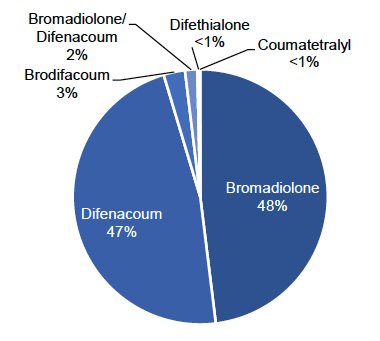
The estimated weights of the three main rodenticides recorded in the 2016, 2018 and 2020 arable crop surveys are presented in Figure 6. Overall rodenticide use in 2020 (ca. 62 tonnes) was 27 per cent higher than in 2018 (ca. 49 tonnes). However, this increase in use is the first for many years following a longer-term decline in rodenticide use in arable agriculture. Rodenticide use in 2020 was 32 per cent lower than in 2016 (ca. 91 tonnes) and 57 per cent lower than that reported in 2000 (ca. 144 tonnes)(5). This has partly been driven by a decline in the proportion of farms on which baiting is conducted (76 and 61 per cent in 2000 and 2020 respectively) and may also have been influenced by the greater use of PCPs.
At active substance level there was a large increase in the use of difenacoum in 2020 which was 165 per cent higher than in 2018. The use of brodifacoum also increased but the increase (20 per cent) was less marked. In contrast, the use of bromadiolone decreased by 16 per cent between 2018 and 2020. The use of all three of the main active substances were lower than in 2016 (brodifacoum 64 per cent, bromadiolone 33 per cent and difenacoum 27 per cent). The reasons for these changes are unclear and it should be noted that rodent populations, and thus rodenticide use, fluctuate over time. Prior to 2020, the decline in rodenticide use and increased use in PCPs, which were detected in both arable and grass and fodder crop systems, were thought to have been influenced by the Campaign for Responsible Rodenticide Usage (CRRU) guidance for best practice(6) and the 2015 launch of the UK industry led rodenticide stewardship scheme(7). The increase in use recorded in 2020 and the slightly lower use of PCPs may be a one-off exception to this trend influenced by the impact of the pandemic or it could suggest that the impact of the stewardship scheme has plateaued. It is not possible at this time to establish the impact of COVID-19 on farmer baiting operations and to indicate whether the 2020 data is an outlier, however subsequent surveys (the next survey will cover 2022) will provide longer term context. The CRRU Code of Best Practice was revised and published in 2021 following a number of changes about the regulation and permitted practical uses of professional rodenticides (see rodenticide approval and stewardship section for further details). These changes could influence future rodenticide use.
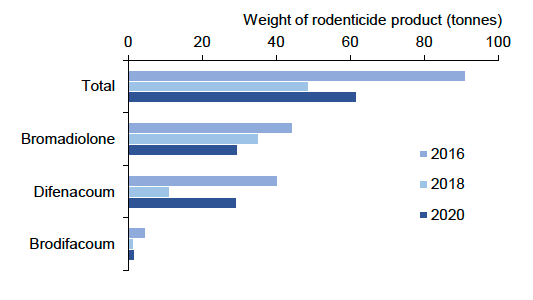
Note mixed bromadiolone/difenacoum formulated products are included in total.
Seasonal use of rodenticides
The season in which rodenticides were used was specified for all the rodenticides encountered in this survey. Forty five per cent of use was reported to occur throughout the year. This included farms practising permanent baiting and those conducting multiple separate baiting operations. This is a decrease from the level reported in 2018 in which 61 per cent of rodenticides were reported to be used throughout the year. However, similar levels of year-round baiting for anticoagulant rodenticides have been reported previously, with 46 per cent in 2016.
When the weight used, including year-round use, is separated into constituent seasons, the greatest use was in winter (38 per cent) and autumn (35 per cent), with lower use in spring and summer (Figure 7). This is a very similar seasonal pattern to that encountered in previous surveys.
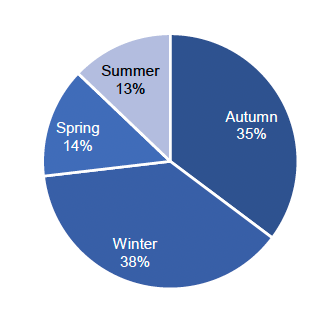
Rodenticide bait type and target
As with the previous survey, baits formulated with grain were the most commonly encountered in this survey, accounting for 82 per cent of use by weight (Figure 8). These baits were primarily loose grain and place packs containing grain, but also included a small amount of grain based paste (<1 per cent of total grain baits).
The other types of rodenticide products encountered included wax based baits, which accounted for 16 per cent of use. Ninety six per cent of wax baits were solid wax baits and four per cent were soft waxes. Pasta based bait contributed two per cent of total use, gel rodenticides and other paste baits (for which the type of bait was not specified) were both estimated to account for less than one per cent.
Grain baits also accounted for the majority of rodenticides used in the previous two arable surveys in 2018 (90 per cent) and 2016 (86 per cent).
Survey respondents were asked to state the target of their rodenticide baiting regimes (Figure 9) and this information was supplied for all estimated use by weight. The most common target was a combination of rats and mice (51 per cent), followed by rats (45 per cent). Only four per cent of rodenticide use was targeted at mice alone. In the previous survey in 2018 the principal target was also a combination of rats and mice (52 per cent). In 2016 the principal target was rats (58 per cent).
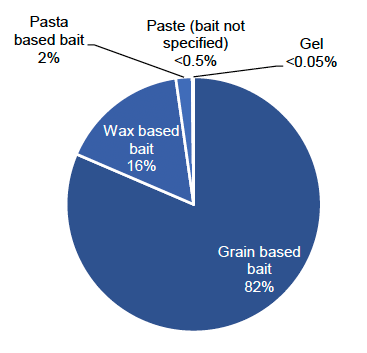
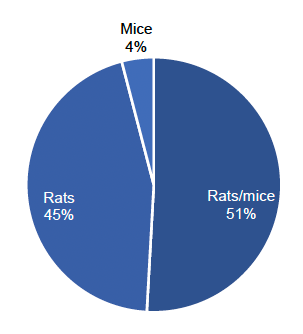
Contact
Email: psu@sasa.gov.scot
There is a problem
Thanks for your feedback